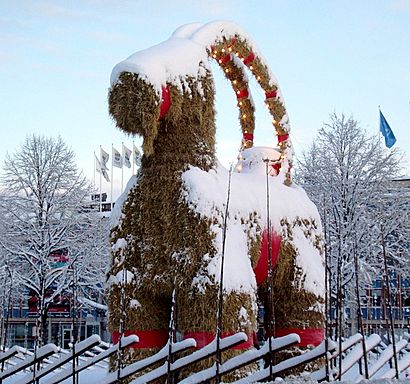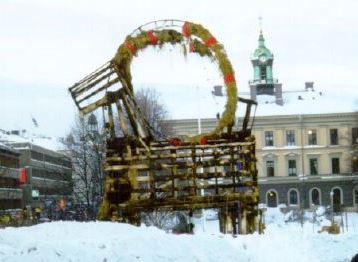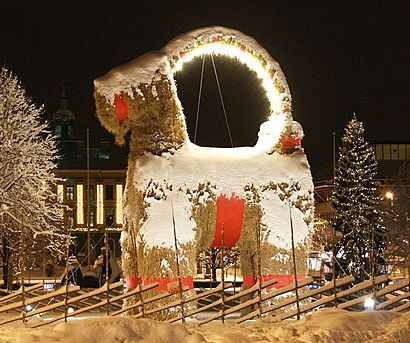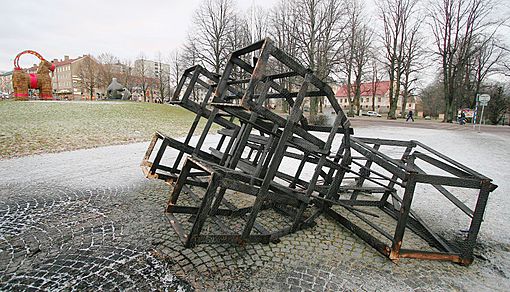Gävle goat facts for kids
The Gävle Goat (Swedish: Gävlebocken) is a giant Yule goat figure. It is built every year in Gävle, Sweden, for Christmas. This huge goat is made of straw. Local groups build it at the start of Advent, which is the Christmas season.
Sadly, the Gävle Goat is often burned down. This has happened many times since it first appeared in 1966. Even with security and a nearby fire station, the goat has been destroyed most years. As of December 2021, 38 out of 56 goats have been damaged or burned. Burning the goat is against the law. People who do it can face serious consequences.
Since 1986, two different Yule Goats have been built in Gävle. One is the main Gävle Goat by the Southern Merchants. The other is a smaller one built by the Natural Science Club of the School of Vasa.
History of the Gävle Goat
The Gävle Goat is put up each year on the first day of Advent. This is usually in late November or early December. In 1966, a man named Stig Gavlén had a great idea. He wanted to build a giant version of the traditional Swedish Yule Goat. He wanted to place it in the town square.
Stig's brother, Jörgen Gavlén, who was the fire chief, designed the first goat. The fire department helped build it. They put up the goat every year from 1966 to 1970 and again from 1986 to 2002. The first goat was very big. It was about 13 meters (43 feet) tall and 7 meters (23 feet) long. It weighed 3 tonnes.
On New Year's Eve in 1966, the first goat was burned down. The person responsible was caught. The goat was insured, so the money for it was returned.
A group of business people called the Southern Merchants took over funding the goat. In 1971, they stopped building it for a while. Then, the Natural Science Club from the School of Vasa started building their own smaller goat. Their goat was about 2 meters (7 feet) tall. People liked their goat, so they kept building it each year. The Southern Merchants started building their big goat again in 1986.
The first goat in 1966 cost about 10,000 Swedish kronor. By 2005, building the goat cost around 100,000 Swedish kronor. The city pays some of the cost, and the Southern Merchants pay the rest.
The Gävle Goat is famous for being a target for people who try to burn it. This has happened many times since 1966. The fire station is very close to where the goat stands. This means fires can often be put out quickly. If the goat burns down before December 13 (Saint Lucia's Day), it is usually rebuilt. Workers repair the wooden frame and put new straw on it.
As of 2005, a few people have been caught for damaging the goat. In 2001, a visitor from the United States burned the goat down. He had to pay a large fine for the damage. He said he thought burning the goat was part of a legal tradition.
In 1996, the Southern Merchants put up cameras to watch the goat all day and night. One year, security guards were watching the goat. It was very cold, so they went into a nearby restaurant to warm up. While they were gone, someone burned the goat.
In December 2005, several Yule Goats across Sweden were attacked. The Gävle Goat was burned on December 3. Other goats in different towns also caught fire.
The year 2006 was the 40th anniversary of the Gävle Goat. The city had a big celebration. The Goat Committee tried to make the goat fireproof. They used a special substance used on airplanes. But even with these efforts, the goat has been damaged or destroyed 38 times. On November 27, 2016, someone burned it down just hours after it was put up. After a few years of being safe, the goat was burned again on December 17, 2021.
Natural Science Club's Yule Goat
Since 1986, there have been two Yule Goats in Gävle. One is the big Gävle Goat by the Southern Merchants. The other is built by the Natural Science Club of the School of Vasa.
For many years, the Southern Merchants' goat was the biggest. But the Natural Science Club's goat grew larger over time. In 1985, their Yule Goat made it into the Guinness World Records. It was officially 12.5 meters (41 feet) tall.
Stig Gavlén, who created the first goat, thought the Natural Science Club's goat didn't deserve the record. He felt it wasn't as nice as the Southern Merchants' goat. The next year, there was a friendly "Goat war." The Southern Merchants built a huge goat to try and get the record back. The Natural Science Club built a smaller one to protest. The Southern Merchants' goat was big, but not big enough for the record.
For the next seven years, no one tried for the world record. There was some friendly rivalry between the two groups. The Natural Science Club even put up a sign wishing everyone a Merry Christmas, "except the Southern Merchants."
In 1993, the Southern Merchants tried for the world record again. Their goat was 10.5 meters (34 feet) tall. But the Natural Science Club's Yule Goat that year was even taller, at 14.9 meters (49 feet). This earned them another spot in the Guinness Book of Records.
See also
 In Spanish: Cabra de Gävle para niños
In Spanish: Cabra de Gävle para niños





